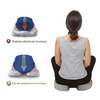Although often minimized, coccyx pain can have a significant impact on our daily lives. Whether it's pain resulting from a fall, muscular tension or pregnancy-related problems, osteopathy offers a whole-body approach that aims to relieve coccygeal pain while treating the underlying causes. Despite its modest appearance, the coccyx is an important part of the bone structure of the human body.
Understanding the coccyx: anatomy and mobility

The coccyx, also known as the coccygeal bone, is the bony structure located at the lowest part of the human spine. It lies below the sacrum and above the anal canal. It consists of four or five fused coccygeal vertebrae, and is triangular in shape with the point downwards. It curves forward towards the pelvic cavity. Often considered a human anatomical relic, numerous muscles and ligaments attach to the coccyx. These structures contribute to the coccyx's stability and are important for functions such as posture, walking and participation in pelvic movements.
The mobility of the coccyx varies from person to person. Generally, the vertebrae of the coccyx are partially mobile, although this mobility may decrease with age or due to various factors such as injury, structural abnormalities or medical conditions. The coccyx follows the movements of the sacrum, moving mainly forwards, backwards and some sideways. During childbirth, the coccyx moves more and may tilt outwards to facilitate the baby's passage through the pelvic canal. This process is known as "mobilization of the coccyx".
It's important to note that although the coccyx is a relatively small structure, it plays a functional role and can be a source of pain when problems arise.
Coccyx pain
Various coccygeal pain triggers
The coccyx can be the site of various types of pain, often with more or less obvious triggers. These include
- directtrauma and falls to the coccyx area can result in bruising, contusions or even fractures of the coccyx.
- muscular tension in the muscles surrounding the coccyx can cause pain. This can result from prolonged sitting, certain sports or repetitive movements.
- jointdysfunctions in the joints between the coccygeal vertebrae can cause pain, linked to degenerative changes or trauma.
- Pregnancy or post-partumproblems . Pregnant women may experience coccyx pain due to the increased pressure on this area during pregnancy, and childbirth can also lead to coccyx strain or injury.
- ...

Various symptoms of coccygeal pain
The pain is particularly pronounced at the base of the spine, on the coccyx, causing heightened sensitivity to touch or direct pressure on the coccyx. This explains why pain is often increased by sitting and certain movements, such as standing up or sitting down, trigger stronger pain.
Consult an osteopath for your coccyx
The osteopath will of course try to understand your pain as well as possible, so as to understand where it comes from and how it is caused, in order to diagnose you correctly and provide comprehensive treatment. After a fall or direct trauma to the coccyx, the osteopath can help relieve pain by working to reduce inflammation, restore mobility and prevent muscular compensation. Osteopathy can also play a role in post-traumatic rebalancing by treating muscular compensations that may develop after a coccyx injury. In the case of chronic coccygeal pain, the osteopath works to identify the underlying causes, whether postural imbalances, persistent muscle tension or other contributing factors. Each osteopathic session is tailored to the patient's specific needs, ensuring personalized treatment according to the nature and duration of coccyx pain. In addition, the osteopath plays an educational role by advising on healthy postures, adapted exercises and lifestyle modifications to prevent recurrence of tailbone pain.

Tips to relieve coccygeal pain
Here are a few tips that may help relieve the discomfort. However, it is important to consult a healthcare professional for an accurate diagnosis and an appropriate treatment plan:
- avoid sitting directly on the coccyx, so use donut-shaped cushions or cushions specially designed to relieve pressure on this area.
- application of ice or heat: for the first 48 hours after the onset of pain, you can apply ice to reduce inflammation, then move on to the application of heat to relax the muscles.
- specific muscle-strengthening exercises to strengthen the muscles around the coccyx, contributing to greater stability.
- avoid activities that aggravate your pain, such as sitting for long periods or exercises that put excessive pressure on the area.
- Massage and gentle stretching can help relax tense muscles around the coccyx. Gentle stretching can also be beneficial, but make sure you don't force the area.
Remember that this advice is general and may vary depending on the underlying cause of your coccygeal pain. It's essential to consult a healthcare professional for advice tailored to your specific situation.

Conclusion
In conclusion, osteopathy offers a holistic approach to relieving tailbone pain by treating not only the symptoms, but also the underlying causes. Through gentle manual techniques, a thorough understanding of the body's biomechanics, and an individualized approach, osteopathy can play a vital role in the lasting relief of tailbone pain. If you suffer from coccygeal pain, consult an osteopath for a full assessment and a treatment plan tailored to your individual needs.
